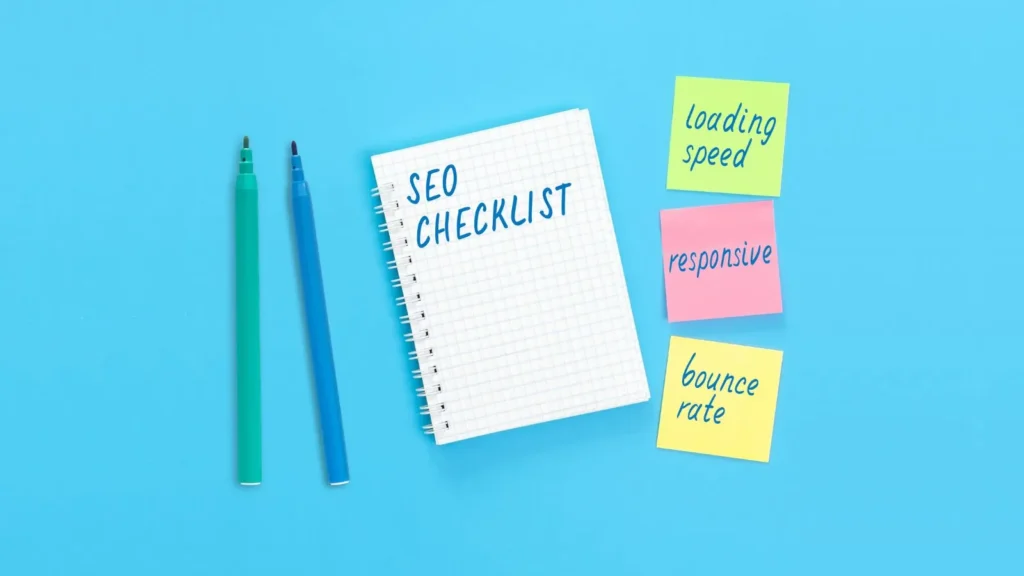If your website isn’t ranking, converting, or getting noticed in 2025, chances are you’re missing something under the hood. SEO isn’t guesswork anymore. It’s technical, strategic, and constantly evolving. That’s exactly why a solid SEO audit checklist matters in 2025: to stop guessing and start fixing what’s actually holding your site back.
We’re not talking about surface-level advice like “use keywords” or “write quality content.” You need a full-scope audit that actually tells you what’s wrong, what’s outdated, and what’s slowing you down in Google’s eyes.
This guide is built for digital marketers, business owners, and content teams who want a real process. We’re going to walk through every layer of what makes a site SEO-healthy in today’s landscape: from crawling and indexing to Core Web Vitals, content gaps, backlink profiles, and more.
If you want to stay competitive in 2025, this is the only comprehensive SEO audit checklist you need.
What Is an SEO Audit in 2025?
An SEO audit in 2025 is more than just scanning for broken links or checking if your meta descriptions are too long. It’s a full diagnostic of your website’s SEO health; from how search engines crawl your pages to how users experience your site on mobile.
Think of it like a site performance review. You’re identifying issues across technical SEO, on-page content, backlinks, UX, and even Core Web Vitals. The goal? To uncover what’s working, what’s outdated, and what’s blocking your rankings – all before Google penalizes you for it.
Compared to SEO audits from 2020 or even 2022, the game has changed. Search engines are smarter. Google’s AI-driven updates like the Helpful Content System and SGE (Search Generative Experience) have shifted how content is ranked and displayed. In 2025, a modern and comprehensive SEO audit checklist needs to account for things like:
- AI-generated summaries and how your site content feeds into them
- Search intent optimization (not just keywords, but relevance)
- Technical SEO health: page speed, structured data, indexability
- Mobile-first UX and accessibility
- E-E-A-T signals (Experience, Expertise, Authoritativeness, Trustworthiness)
Even if your site ‘looks fine’, you could be losing traffic due to silent issues, like crawl errors, duplicate content, bloated JavaScript, or stale backlinks. A comprehensive SEO audit checklist for 2025 makes sure none of these are missed.

Why You Need a Comprehensive Audit And Not Just a Quick Fix
A quick SEO scan can catch a few broken links or flag missing tags; but that’s not going to keep your site competitive in 2025. What you need is a comprehensive SEO audit, not just a band-aid fix.
Why? Because SEO isn’t a one-and-done job. Your competitors aren’t standing still. Google’s algorithm updates are more frequent, more complex, and increasingly driven by AI. If you’re not staying ahead, you’re falling behind.
- Skipping an in-depth audit or relying on basic tools could lead to:
- Ranking drops without warning (and no idea why)
- Missed revenue due to poor site structure or invisible pages
- Outdated content that no longer matches search intent
- Technical issues like crawl errors, duplicate content, or bloated code
Google’s emphasis on page experience, relevance, and authority has only grown. That means even small SEO missteps, like slow-loading mobile pages or thin content, can affect how your site performs across search. In 2025, maintaining your search engine visibility requires more than tweaking headlines or adding keywords.
A full audit helps you uncover blind spots: Are you missing key internal links that boost authority? Is your content strategy aligned with user intent? Are you building backlinks from credible sources or leaving that to chance?
If your site brings in leads or sales, a deep audit should be part of your regular SEO maintenance. It protects your rankings, grows your authority, and ensures your website is working for you – not against you.
The 2025 Comprehensive SEO Audit Checklist
A proper SEO audit in 2025 isn’t about surface-level fixes, it’s a deep scan of your site’s health, performance, and visibility. Here’s what your comprehensive SEO audit checklist for 2025 must cover:
Technical SEO Checks
Your foundation matters. Google’s bots can’t rank what they can’t properly crawl.
- Mobile-Friendliness: With Google indexing mobile-first, your site must perform smoothly across devices. Test using Google’s Mobile-Friendly Test.
- Site Speed: A slow site loses visitors fast. Use PageSpeed Insights or Core Web Vitals to catch loading lags.
- Crawl Errors & Broken Links: Use Google Search Console to fix 404 errors, redirect chains, or broken internal links.
- HTTPS & URL Structure: Secure your site (SSL certificate) and clean up messy URLs. Consistent, human-readable URLs boost both SEO and trust.
- Internal Linking: Check that your key pages are internally linked in a logical hierarchy as it helps search engines and users navigate your content more efficiently.
On-Page SEO Checks
Think of on-page SEO as your on-page hygiene, every detail matters.
- Title Tags & Meta Descriptions: Are they unique, compelling, and under character limits? Do they include keywords naturally?
- Header Structure: A proper H1-H2-H3 flow improves both readability and crawlability.
- Keyword Placement: Make sure that your main and secondary keywords (LSIs) are placed naturally, no stuffing.
- Image Optimization: Every image should have descriptive alt text and be compressed for faster load times.
- Duplicate Content: Scan for duplication across pages. Tools like Siteliner or Copyscape help.
Content Quality & Relevance
Content still wins, but only if it’s useful and up-to-date.
- Outdated Pages: Blogs from 2019 won’t cut it. Refresh old content to align with current trends and algorithm updates.
- Content Gaps: What’s your competitor covering that you’re not? Use tools like Ahrefs’ Content Gap or SEMrush’s Topic Research.
- Topical Authority: Cover topics thoroughly, not thinly. Google now rewards depth and relevance.
- Content Balance: Ensure your blog, service pages, and landing pages are working together, not competing with each other.
Off-Page SEO Checks
Google doesn’t just look at your site; it listens to what the internet says about you.
- Backlink Profile: A healthy backlink mix from reputable sources signals authority. It’s not about quantity, but quality.
- Toxic Links: Audit for spammy or irrelevant links and disavow them if needed.
- Digital PR & HARO: Submitting expert quotes through platforms like HARO can earn organic backlinks from news outlets.
- Social Signals: While not direct ranking factors, engagement and brand mentions across platforms help build trust.
Local SEO (If Applicable)
If you serve a local audience, local SEO can’t be an afterthought.
- Google Business Profile (GBP): Make sure your GBP is filled with correct info, photos, and regular updates.
- NAP Consistency: Your Name, Address, and Phone Number must match across your website, directories, and listings.
- Reviews: Positive, fresh reviews help you stand out in Google Maps results. Ask happy customers, but ethically.
- Local Citations: List your business on trusted directories (Yelp, YellowPages, BBB, etc.).
Analytics & Performance Tracking
What’s measured improves, but only if you’re measuring the right things.
- GA4 & GSC Integration: Ensure your site is connected to both Google Analytics 4 and Search Console. Check they’re collecting data correctly.
- Top Performing Pages: See which content is bringing in traffic and converting double down on what’s working.
- Bounce Rate & Dwell Time: High bounce? Look into page load time or content relevance.
- Conversion Paths: Map how users move from entry to goal. Are there unnecessary drop-offs?
- Traffic Sources: Know where your visitors come from: organic, referral, direct, or paid?

Free Tools to Use for Your Audit
You don’t need an expensive stack of enterprise tools to run a solid SEO audit; some of the most powerful audit software is either free or offers a robust free tier. Here are the tools we recommend every site owner or digital marketer explore in 2025:
PageSpeed Insights (by Google)
Purpose: Analyze and improve your website’s load speed and Core Web Vitals.
Why it matters: Site speed is a major ranking and UX factor. A fast site improves bounce rate, conversion rate, and mobile usability.
How to use it:
- Enter any URL to receive a score (out of 100) for mobile and desktop performance.
- You’ll get actionable suggestions like reducing unused JavaScript, image optimization, or implementing lazy loading.
Pro tip: Use it alongside Lighthouse for a more technical breakdown.
Google Search Console
Purpose: Monitor how Google crawls, indexes, and ranks your site.
Why it matters: It’s your direct line to Google’s understanding of your website.
How to use it:
- Identify crawl errors, coverage issues, and indexing problems.
- Monitor top-performing queries, pages, and click-through rates (CTR).
- Submit new URLs or sitemaps for faster indexing.
Bonus Tip: Set up performance filters by query or page to monitor drops and identify SEO opportunities.
Screaming Frog (Free Version)
Purpose: Crawl your website like a search engine would.
Why it matters: It shows you a detailed snapshot of every technical element of your site, from title tags and meta descriptions to broken links and redirects.
How to use it:
- Download the desktop tool and crawl up to 500 URLs for free.
- Identify missing alt text, duplicate content, redirect chains, and thin pages.
- Export issues into a spreadsheet for easy fixing with your dev team or CMS.
Why we like it: For small-to-medium websites, the free version is often enough to catch major issues.
SEMrush / Ahrefs / Ubersuggest (Free Tiers)
Purpose: Analyze backlinks, content gaps, keyword opportunities, and overall SEO health.
Why it matters: These tools offer a bird’s-eye view of your domain and how it stacks up against competitors.
How to use them:
- Run a site audit to detect crawl issues, slow pages, or content duplication.
- Use the keyword explorer to discover new ranking opportunities.
- Run backlink audits to evaluate link quality and track toxic domains.
Pro tip:
Ubersuggest offers more in its free tier, while SEMrush and Ahrefs offer limited data without a subscription, but it’s still useful for quick checks and comparisons.
The right tools don’t just diagnose SEO issues, they uncover opportunities. Using a combination of Google-native tools and third-party analysis platforms, you can get both granular and big-picture insights that feed into smarter content, better UX, and higher search visibility.

Common SEO Audit Mistakes to Avoid
Even experienced marketers can fall into these traps during an SEO audit. Some oversights are the result of rushing. Others come from a misunderstanding of what search engines actually prioritize in 2025. Here’s a breakdown of the most common (and costly) SEO audit mistakes and how to avoid them.
1. Relying Only on Tools
The mistake:
Plugging your site into an audit tool and calling it a day.
Why it’s risky:
Tools like SEMrush, Ahrefs, or Screaming Frog are powerful, but they only show surface-level issues. They can’t judge content quality, understand brand voice, or tell you why your audience isn’t converting.
How to avoid it:
Pair your tool-generated reports with manual reviews:
- Read your key landing pages as if you’re a first-time visitor. Are they helpful, clear, and persuasive?
- Compare your content with your top three competitors, do you add unique value?
- Check if internal links guide users logically from awareness to conversion.
2. Ignoring User Experience (UX)
The mistake:
Focusing only on keyword placement, backlinks, and technical SEO, while forgetting how the site feels to real users.
Why it’s risky:
Google has made it clear: if users aren’t satisfied, you don’t rank. A site that loads slowly, looks cluttered on mobile, or buries its content under popups will bleed traffic no matter how “optimized” it looks on paper.
Key UX issues to look for during an audit:
- Layout clutter: Too many CTAs or banner ads confuse users.
- Navigation structure: Can users find what they need in 2–3 clicks?
- Content readability: Walls of text with no formatting or headings drive bounce rates.
- Mobile friendliness: Is your mobile version touch-friendly and fast?
3. Forgetting to Re-Audit After Making Changes
The mistake:
Assuming your work is done after implementing SEO fixes.
Why it’s risky:
SEO is dynamic. One change can affect another, and some fixes may not work as expected. If you don’t go back and re-audit, you’ll never know what helped, what broke, or what still needs attention.
How to avoid it:
- Schedule a mini-audit 2–4 weeks after major updates.
- Use Google Search Console and GA4 to track changes in impressions, clicks, and rankings.
- Watch for new errors (especially technical) that might arise after implementing fixes.
Bonus tip:
Use annotations in GA4 or campaign notes to track what was done and when. It makes measuring impact easier.
4. Skipping Mobile & Technical Checks
The mistake:
Assuming your desktop site is solid and forgetting to dig deeper into mobile or backend performance.
Why it’s risky:
Over 60% of web traffic is mobile in 2025. And even slight technical issues (like redirect loops, mixed content, or bloated JS) can crush rankings and crawlability.
Common technical issues to audit:
- Mobile usability errors in Search Console
- Core Web Vitals (especially Largest Contentful Paint and Cumulative Layout Shift)
- HTTPS implementation and SSL expiry checks
- XML sitemap and robots.txt functionality
- 404s and redirect chains
How to check:
Use a combo of PageSpeed Insights, Screaming Frog, and GSC to isolate problems. Then test your site’s mobile experience manually, not just with a simulator.
The most dangerous SEO mistake? Treating an audit as a checklist instead of a strategic process. A good audit goes beyond red flags, it maps out where you are, why you’re stuck, and how to grow.

How Often Should You Run an SEO Audit?
Think of your website like a car. Even if it’s running fine today, that doesn’t mean it’s ready for a road trip next month. Things break down quietly: rankings drop, links go stale, new competitors outrank you and most businesses don’t notice until traffic slows to a crawl.
That’s why SEO audits shouldn’t be a one-time thing.
Quarterly or Bi-Annual Audits (The Standard)
Every 3–6 months is the sweet spot for most businesses. Why?
- Search engine algorithms keep evolving.
- Your competitors may update their sites or launch fresh content.
- Pages that once ranked #1 can slip without warning.
Regular audits give you a chance to catch these shifts early, before they impact leads or revenue.
Quick reality check:
If you’re publishing content consistently or running paid campaigns, you should probably lean toward quarterly audits. More activity = more moving parts to check.
When to Run an Extra Audit
Beyond your regular schedule, certain milestones call for an additional SEO checkup:
1. Launching a New Website or Redesign
New sites often come with missed redirects, broken links, or mobile issues that weren’t caught in testing.
2. Starting a New Marketing Campaign
Before driving paid traffic, make sure your pages are optimized to convert and technically sound. No point in sending users to a slow or broken site.
3. After Major Algorithm Updates
Google rolls out major changes at least 2–3 times a year. If you’ve seen sudden ranking shifts, a quick audit can uncover if you were affected.
4. After a Drop in Traffic or Conversions
If something’s off, start with the basics: Check crawlability, indexing, page speed, and key content changes. Even one broken meta tag can tank a page’s visibility.
Audit Rhythm That Works
| Business Type | Audit Frequency | Why? |
| Local business with stable content | Every 6 months | Fewer changes, slower SEO shifts |
| Active blog or eCommerce store | Every 3 months | Constant updates = more risk |
| Launching a new site or major campaign | Extra audit before launch | Prevent missed SEO issues |
| Noticing traffic or ranking drops | As needed | Quick fix > long-term loss |
SEO is like fitness, you don’t get lasting results from a single workout. Consistency is what protects rankings, traffic, and your competitive edge.
Your Next Steps
If you’ve made it this far, you clearly care about your site’s performance, and that’s half the battle. SEO in 2025 isn’t just about keywords or backlinks anymore. It’s about understanding your entire digital footprint, from technical stability to user experience, and keeping pace with constant changes.
But here’s the truth: You don’t need to do it all alone.
A comprehensive SEO audit doesn’t just find problems but it gives you a roadmap. It tells you what’s working, what’s holding you back, and where the real growth opportunities lie.
At Rank Ray, we’ve helped countless brands get clarity through detailed, no-fluff audits that actually move the needle. Whether you’re launching something new or trying to reverse a ranking drop, our SEO team is ready to dig deep and deliver a clear path forward.
Frequently Asked Questions
1. What is a comprehensive SEO audit?
It’s a full review of your website’s SEO performance: covering technical setup, content quality, backlink health, on-page elements, and user experience, to find issues and opportunities for better rankings.
2. How often should I do an SEO audit?
Most sites benefit from an audit every 3–6 months. You should also audit when launching a new site, starting a campaign, or after a major Google update.
3. Can I do an SEO audit myself for free?
Yes, using tools like Google Search Console, PageSpeed Insights, and Screaming Frog. However, in-depth audits often require paid tools and SEO expertise to interpret the results accurately.
4. What’s the biggest mistake in SEO audits?
Relying only on tools without understanding the bigger picture (like user experience, mobile usability, or outdated content) can lead to missed insights.







